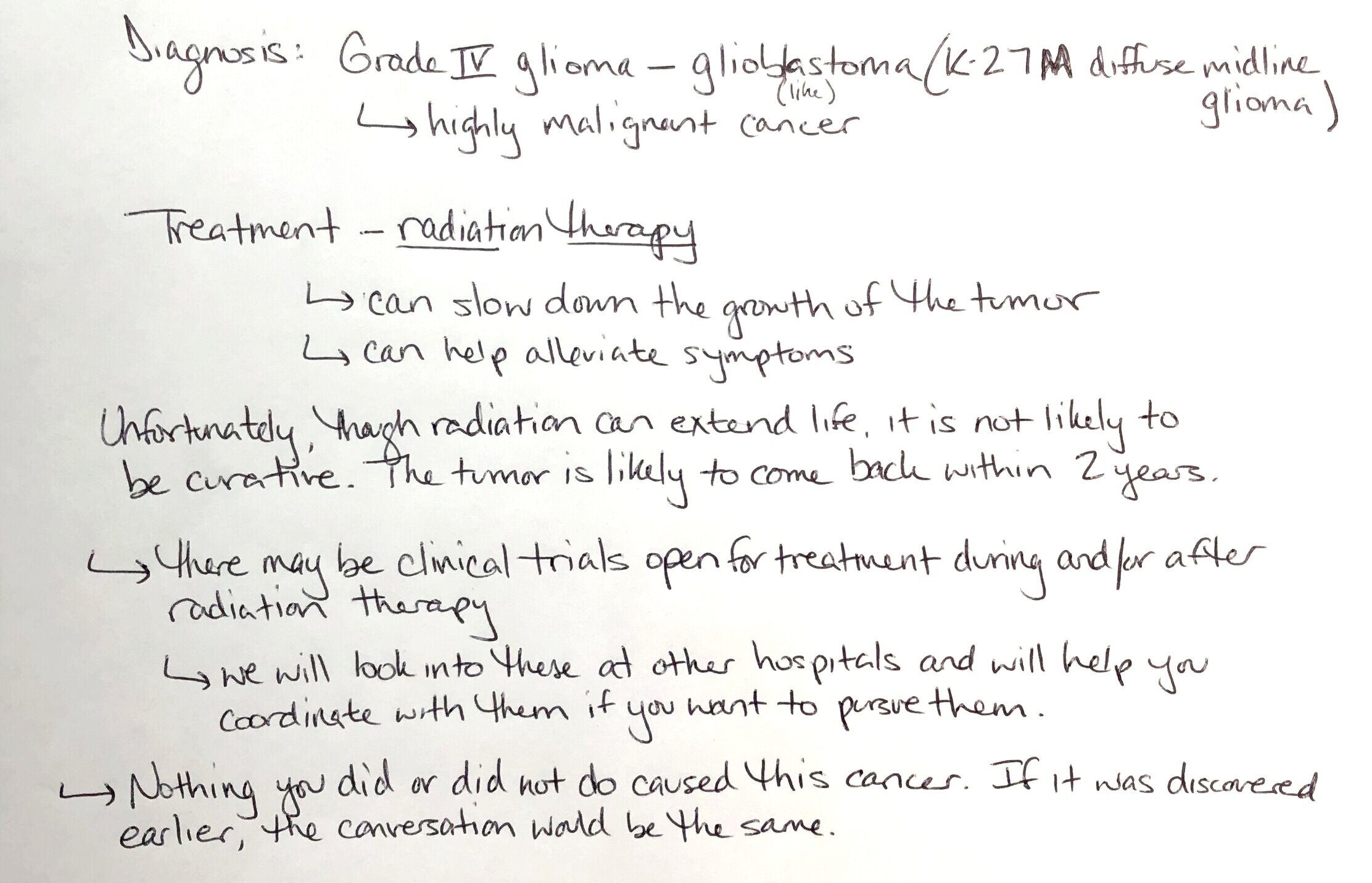SHE DESERVED BETTER OPTIONS
One major advancement in the fight against Diffuse Midline Glioma (DMG) is the intracranial biopsy. Up until the early 2000s, biopsies weren’t even performed on children with brain-stem tumors – it was considered too dangerous. Today, new methods in brain tissue sampling, combined with genomic testing, give neuro oncologists the ability to identify the exact type of tumor a family is up against.
Five days after Annalise’s biopsy, we sat down with her oncology team to find out her pathology results. At that time, we didn’t even know if it was a benign or malignant tumor. To think the latter was unimaginable. I woke up that morning feeling positive about the meeting.
As soon as we walked into the room, I could tell by the looks on the team’s faces that they were about to drop another bomb on us.
With a tear in her eye, I recall Annalise’s neuro oncologist say, “Unfortunately, it’s the most aggressive type.”
They slid a piece of paper across the table that had a bunch of words on it…
We cried. Everybody cried. It was inoperable, aggressive and incurable. I went into Dad mode. “Is there anything experimental we can try? Clinical trials?,” I asked (although, I probably shouted this). Our team said they’d look into trials, but for now, the only approved course of action for a glioma of this nature was radiation. That’s it. Chemotherapy wasn’t even on the table.
Today, somewhere, a family is receiving similar horrific news. And like us, they will start their quest for hope that some new breakthrough will come along to save their child. The 5-year survival rate for Annalise’s type of brain tumor is 2% with the vast majority succumbing to the disease within 9 months from diagnosis. Annalise survived almost 7 months post D-day. Like every family, we were determined to be the exception. We wanted to be in that 2%. I absolutely believed if we could get her one year, that the science would catch up to her and that one year would be two, and that two would be ten. We were aggressive, contacting some of the foremost pediatric brain cancer researchers in the nation and connecting them with our oncology team here in Philadelphia. Due to timing and very limited options, we chose to go with a clinical trial for a new chemotherapy that had shown effectiveness in some H3K27M mutant gliomas. Although this chemotherapy has kept some children alive past the 2-year mark, it simply didn’t work for Annalise. It was our only hope. Our only option.
Only 2 new treatments for brain tumors have been approved in the past 25 years.
Less than 4% of NIH/NCI’s budget is directed at childhood cancer research, of which only a fraction (about 1%) of these funds are used for children’s brain tumor research.
Clearly, the amount of institutional funding that goes toward pediatric brain tumor research is grossly insufficient. Some say this is due to the rarity of the disease. When it’s your child or a child of one of the hundreds of families we’ve come to know in this “Worst Club in the World,” it doesn’t feel rare at all. Our children aren’t statistics. They deserve better options. Annalise certainly deserved better. To date, the vast majority of research has largely been funded through philanthropy and the efforts of courageous families who’ve lost children to this disease. Today, we’re joining their ranks.
IT’S BRAIN TUMOR AWARENESS MONTH
we’re
DONATING to
help find
better options
$9000 in May, in memory of our Annalise – forever 9.
First up…
Children’s
Brain Tumor
Tissue
Consortium
CBTTC.org
WHY the CBTTC?
1
We believe that the only way to find a cure is through joint efforts and collaboration. The consortium is a network of researchers and allow any researcher access to the precious data.
2
The CBTTC operations center is at CHOP and Annalise’s neurosurgeon, Dr. Storm, is a leader. We trusted Dr. Storm to perform brain surgery on our daughter twice. Annalise’s Neuro-Oncologist, Dr. Cole, has supported us throughout this journey and is committed to continuing to support us. We truly believe Annalise’s doctors all want better treatments for their patients.
3
Most importantly, we donated Annalise’s brain tissue to the CBTTC in hopes that her gift would assist in finding a cure one day.
Thanks to the CBTTC,
Annalise is still helping the fight
even after she’s gone.
Thank you to every one who donated to our family and/or to the CBTTC.
Your generosity and kindness have made this mission possible.


